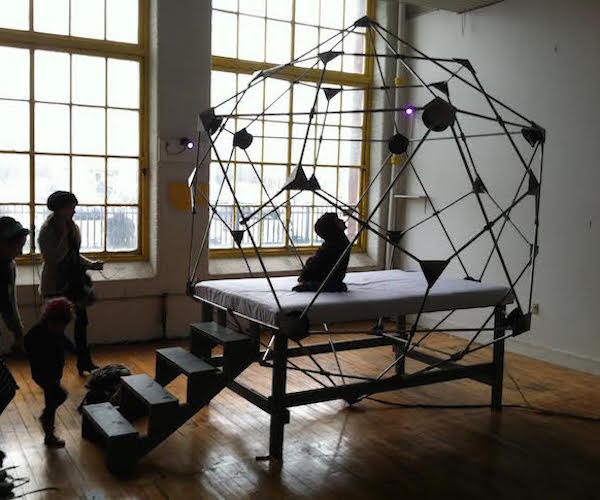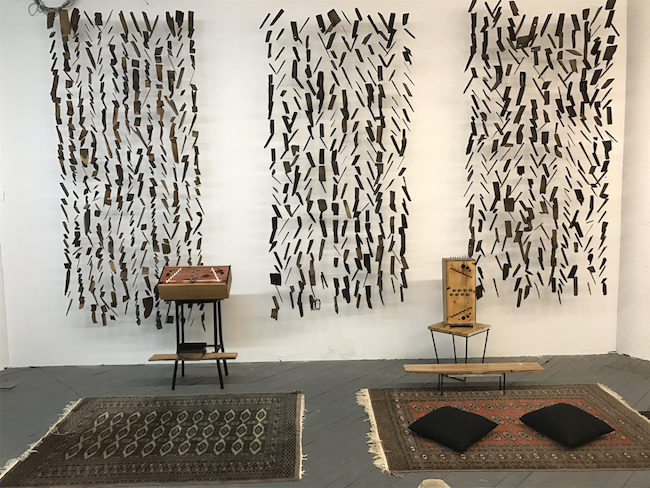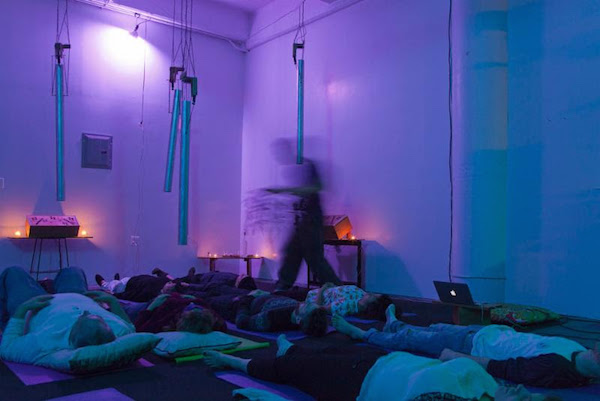Visual Arts Review: “Vibrations: A Sound Experience” at Boston Cyberarts Gallery
With Vibrations: A Sound Experience, Boston CyberArts continued to live up to its demanding mandate — to expand our artistic horizons.

“Sonotron” by Derek Hoffend at “Vibrations: A Sound Experience.” Photo: Boston Cyberarts
By Mark Favermann
It is good to be reminded that contemporary art can be more than just about the visual. It can present sophisticated and layered aural experiences as well. That is the valuable lesson the Boston Cyberarts Gallery recently served up via its consciousness expanding (and contracting) sensory immersive show Vibrations: A Sound Experience (Closed). The Jamaica Plain location of the Cyberarts Gallery — above the MBTA’s Orange Line/Green Street Station — aided the experience: the occasional roaring, rumblings, screeches, and tremors of the trains below added to the sonic mix. In this setting, sound is always a part of the aesthetic.
The interactive sound exhibition contains work by MJ Caselden and Derek Hoffend. Utilizing immersive and experiential sound techniques, while also drawing on vibrations and magnetism, the show reflected the visions of two artists who see art and its exhibition space as tools for transformation: the goal is to expand viewers consciousness, to cultivate experiences of transcendence.
Both of the show’s artists are highly influenced by the therapeutic properties perceptible in sound. In that spirit, they both thoughtfully make use of meditative concepts in their work. The immersive quality of their approach is made up of a number of component parts: experiential modes, meditative techniques, the rhythm of resonance, and the medicinal aspects of contemplative self-reflection among them. In addition, the sound pieces in this exhibition are distinctively physical — viewers are asked to interact, to touch and handle the art.
Each artist draws from the sound philosophy of Somaesthetics, the interdisciplinary field of inquiry that promotes and integrates theoretical, empirical, and practical ideas from disciplines related to perception, performance, and presentation. The approach was developed by pragmatist thinker Richard Shusterman during the 1990s.

MJ Caselden’s “Wood Hanging Tonal Piece” at “Vibrations: A Sound Experience.” Photo: Boston Cyberarts.
Attempting to unlock aspects of the unconscious mind, Vibrations: A Sound Experience consisted of works that were inspired by what could be called audio aesthetics, art whose sonic mission was to invite visitors to access concealed metaphysical/psychological spaces. In their pieces, Caselden and Hoffend generated myriad ‘colors of sound’ through repetition, setting up a kind of ritualized listening. Their sound-generating sculptures generated invisible ‘sonic’ colors, hues created by timbre (tone color or quality), pitch, harmony, melody, rhythm, texture, and dynamics. The artists wanted to surround listeners by forming immersive listening spaces that demanded contemplation.
All of this abstract explanation may sound esoteric, but in reality the exhibit was accessible and surprisingly visitor-friendly, both strangely appealing and recognizably strange. Think of Gregorian Chants morphing into Tuvin (Mongol) Throat Singing. Thoughtfully curated by Stephanie Dvareckas, the assistant director of Boston Cyberarts, the exhibit’s visuals were also quite appealing, intellectually as well as aesthetically.
Two of the show’s pieces stood out. With a bow and a tip of the hat to visionary architect/theorist/inventor Buckminster Fuller (his dodecahedron geodesic dome in particular), Hoffend’s “Sonotron” succeeds as an immersive sound and light environmental structure. Caselden’s wall hanging (made up of wooden pieces) allude to the clappers of the “bells” utopian architect Paolo Solari’s sold to pay for the construction of his life’s work, Arcosanti, in the Arizona desert. The complex tonality of the individual wooden pieces adds to the work’s meditative power.
Caselden considers himself both a sound artist and an inventor. He heads up a design firm in New York City that is dedicated to prototyping innovative uses of technology for artists and tech companies. His art often revolves around experiences of ritualized listening: either via guided group meditations or in the form of sound-generating sculptures. His “Magnetic Sound” sculptures vary magnetic fields in order to induce vibrations in metal and wood. Caselden feels that this magnetic energy creates repetitive, mantra-like vibrations that are conducive to meditation. To this mystical end, the artist also collaborates with teachers from long-standing healing arts practices, such as Asana Yoga, Tibetan Tummo breathwork, acupuncture, and Ch’an meditation.

MJ Caselden’s “Sound Bath” at “Vibrations: A Sound Experience.” Photo: Boston Cyberarts.
Hoffend creates installations that combine sculptural forms with sound and interactive experiences. His artworks make use of sonic, electronic, and physical media as well as light, space, and the human body to create fascinating inner personal adventures. His most recent work explores ways in which somatosensory responses, therapeutic experiences, and shifts in consciousness can be facilitated in viewers.
This is an artist who is particularly interested in creating spaces where scientific and metaphysical ideas can cohabitate. Hoffend wants to create a bridge between the physical and supernatural, to mingle sensory and spiritual experiences. To this end, he draws on a variety of processes and theories, such as vibro-acoustics to create a haptic experience, entrainment theory (rhythmic, biomusical, and neural acoustic phenomena such as monaural and binaural beating), and components of sound therapy, sacred-geometry, and color therapy. Biofeedback principles and techniques are also employed, often through the use of heart-rate monitors that trigger sound and light feedback.
With Vibrations: A Sound Experience, Boston CyberArts continued to live up to its demanding mandate — to expand our artistic horizons.
An urban designer, Mark Favermann has been deeply involved in community branding, enhancing, and making more accessible parts of cities, sports venues, and key institutions. Also an award-winning public artist, he creates functional public art as civic design. Mark created the Looks of the 1996 Centennial Olympic Games in Atlanta, the 1999 Ryder Cup Matches in Brookline, MA, and the 2000 NCAA Final Four in Indianapolis. The designer of the renovated Coolidge Corner Theatre, he has been a design consultant to the Red Sox since 2002. An Associate Editor of The Arts Fuse, Mark writes on architecture, design, and the fine arts.
Tagged: A Sound Experience, Boston Cyberarts, Boston Cyberarts Gallery, Derek Hoffend, Mark Favermann, MJ Caselden
